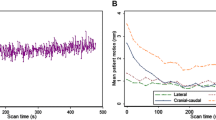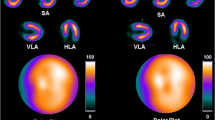Abstract
Purpose
Myocardial perfusion SPECT is an excellent tool for the assessment of coronary artery disease (CAD); however, it is affected by several artifacts, such as patient motion during acquisition, which increases false-positive rates. Therefore, the purpose of this work is to analyze changes in perfusion scores after motion-correction software application.
Methods
The population included 160 99mTc-sestamibi CAD studies, divided into two groups: with and without perfusion defects, equally divided into subgroups according to movement during standard acquisition. A Siemens ECAM 180 was used for processing without correction and with automatic and manual e.soft 2.5 modalities. Visual interpretation as well as QPS software was compared using Pearson correlation and kappa agreement statistics.
Results
Moderate agreement was observed between SPECT interpretations after motion correction versus the original report, according to the presence of perfusion defects. Manual correction using the software obtained the lowest agreements. Perfusion summed stress scores (SSS) correlation from different processing modalities versus non-corrected studies differed significantly independent of the degree of motion. Mean SSS in 40 patients with no motion was 3.9 ± 3.9 when no correction was applied; with automatic correction was 8.8 ± 10 (p = 0.03) and with manual correction was 3.1 ± 3.5 (p = ns versus non-corrected). Automatic correction was better when applied to patients with mild to moderate motion. In those with mild or no motion, software overestimated or created new perfusion defects.
Conclusion
Motion-correction software must be used with caution when trying to optimize myocardial perfusion SPECT based on individual analysis. Acquisition should be always repeated in cases with severe motion and in no or mild motion it seems preferable to avoid correction.


Similar content being viewed by others
References
DePuey EG, Garcia EY. Optimal specificity of thallium-201 SPECT through recognition of imaging artifacts. J Nucl Med. 1989;30:441–9.
DePuey EG. How to detect and avoid myocardial perfusion SPECT artifacts. J Nucl Med. 1994;35:699–702.
Fitzgerald J, Danias PG. Effect of motion on cardiac SPECT imaging: recognition and motion correction. J Nucl Cardiol. 2001;8:701–6.
Botvinick EH, Zhu YY, O’Connel WJl, Dae MW. A quantitative assessment of patient motion and its effect on myocardial perfusion SPECT images. J Nucl Med. 1993;34:303–10.
Prigent FM, Hyun M, Berman DS, Rozanski A. Effect of motion on thallium-201 SPECT studies: a simulation and clinical study. J Nucl Med. 1993;34:1845–50.
Friedman J, Van Train K, Maddali J, Rozanski A, Prigent F, Bietendorf J, et al. “Upward creep” of the heart: a frequent source of false-positive reversible defects during thallium-201 stress redistribution SPECT. J Nucl Med. 1989;30:1718–822.
Geckle WJ, Frank TL, Links JM, Becker LC. Correction for patient and organ movement in SPECT: Application to exercise thallium-201 cardiac imaging. J Nucl Med. 1988;29:441–50.
Eisner RL. Sensitivity of SPECT thallium-201 myocardial perfusion imaging to patient motion. J Nucl Med. 1992;33:1571–3.
Eisner R, Churchwell A, Noever T, Nowak D, Cloninger K, Dunn D, et al. Quantitative analysis of the tomographic Thallium-201 myocardial bullseye display: critical role of correcting for patient motion. J Nucl Med. 1988;29:91–7.
Cooper JA, Neumann PH, McCandless BK. Effect of patient motion on tomographic myocardial perfusion imaging. J Nucl Med. 1992;33:1566–71.
Matsumoto N, Berman DS, Kavanagh P, Gerlach J, Hayes SW, Lewin HC, et al. Quantitative assessment of motion artifacts and validation of a new motion-correction program for myocardial perfusion SPECT. J Nucl Med. 2001;42:687–94.
Germano G, Chua T, Kavanagh B, Kiat H, Berman DS. Detection and correction of patient motion in dynamic and static myocardial SPECT using a multi-detector camera. J Nucl Med. 1993;34:1349–55.
Leslie WD, Dupont JO, McDonald D, Peterdy AE. Comparison of motion correction algorithms for cardiac SPECT. J Nucl Med. 1997;38:785–90.
Kiat H, Van Train KF, Friedman JD, Germano G, Silagan G, Wang FP, et al. Quantitative stress-redistribution thallium-201 SPECT using prone imaging: methodologic development and validation. J Nucl Med. 1992;33:1509–15.
Links JM, Becker LC, Rigo P, Taillefer R, Hanelin L, Anstett F, et al. Combined corrections for attenuation, depth-dependent blur, and motion in cardiac SPECT: a multicenter trial. J Nucl Cardiol. 2000;7:414–25.
Bai C, Maddahi J, Kindem J, Conwell R, Gurley M, Old R. Development and evaluation of a new fully automatic motion detection and correction technique in cardiac SPECT imaging. J Nucl Cardiol. 2009;16:580–9.
Matsumoto N, Berman DS, Kavanagh PB, Agafitei RD, Gerlach J, Hayes SW, et al. Motion correction improves specificity of myocardial perfusion SPECT. J Am Col Cardiol. 2001;37(Suppl. 2):411 A.
Tout D, Loong C, Naidoo V, Van Aswegen A, Underwood S. Does motion correction of myocardial perfusion SPECT studies influence the clinical outcome of the study? J Nucl Cardiol. 2005;12:S72.
Uchiyama K, Kaminaga T, Waida M, Yasuda M, Chikamatsu T. Performance of the automated motion correction program for the calculation of left ventricular volume and ejection fraction using quantitative gated SPECT software. Ann Nucl Med. 2005;19:9–15.
Zakavi SR, Zonoozi A, Kakhki VD, Hajizadeh M, Momennezhad M, Ariana K. Image reconstruction using filtered backprojection and iterative method: effect on motion artifacts in myocardial perfusion SPECT. J Nucl Med Technol. 2006;34:220–3.
Djaballah W, Muller MA, Bertrand AC, Marie PY, Chalon B, Djaballah K, et al. Gated SPECT assessment of left ventricular function is sensitive to small patient motions and to low rates of triggering errors: a comparison with equilibrium radionuclide angiography. J Nucl Cardiol. 2005;12:78–85.
Matsumoto N, Berman DS, Kavanagh PB, Waechter P, Gerlach J, Hayes SW, et al. Effect of patient motion on quantitative left ventricular volume an regional wall motion in ECG-gated myocardial perfusion SPECT. J Nucl Med. 2001;42:175P. n° 5,Suppl, abst 758.
Burrell S, MacDonald A. Artifacts and pitfalls in myocardial perfusion imaging. J Nucl Med Technol. 2006;34:193–211.
Acknowledgements
We appreciate the permanent support of our excellent Nuclear Medicine staff of technologists at the University of Chile Clinical Hospital.
Author information
Authors and Affiliations
Corresponding author
Rights and permissions
About this article
Cite this article
Massardo, T., Jaimovich, R., Faure, R. et al. Motion correction and myocardial perfusion SPECT using manufacturer provided software. Does it affect image interpretation?. Eur J Nucl Med Mol Imaging 37, 758–764 (2010). https://doi.org/10.1007/s00259-009-1290-y
Received:
Accepted:
Published:
Issue Date:
DOI: https://doi.org/10.1007/s00259-009-1290-y




